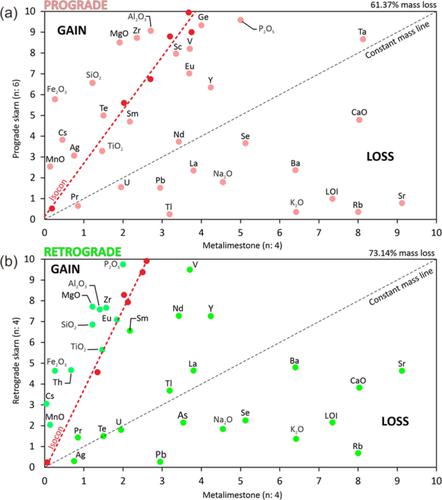当前位置:
X-MOL 学术
›
Resour. Geol.
›
论文详情
Our official English website, www.x-mol.net, welcomes your
feedback! (Note: you will need to create a separate account there.)
Element mobility during formation of the Ruwai Zn-Pb-Ag skarn deposit, Central Borneo, Indonesia
Resource Geology ( IF 1.1 ) Pub Date : 2022-03-29 , DOI: 10.1111/rge.12290 Cendi D. P. Dana 1 , Andrea Agangi 1 , Ryohei Takahashi 1 , Arifudin Idrus 2 , Chun‐Kit Lai 3 , Nico A. Nainggolan 4
Resource Geology ( IF 1.1 ) Pub Date : 2022-03-29 , DOI: 10.1111/rge.12290 Cendi D. P. Dana 1 , Andrea Agangi 1 , Ryohei Takahashi 1 , Arifudin Idrus 2 , Chun‐Kit Lai 3 , Nico A. Nainggolan 4
Affiliation

|
The Ruwai deposit is Indonesia's largest Zn-Pb-Ag skarn deposit and is located in Lamandau district, Central Borneo, within the Central Borneo metallogenic belt. This skarn deposit consists of four main zones, namely Gojo, Karim, Ruwai, and Southwest Gossan Zones. The skarn orebodies are mostly hosted by limestone of the Jurassic Ketapang Complex where quartz diorite of the Cretaceous Sukadana Granitoid is the ore-causative intrusion. Despite the several mineralogical studies carried out in this deposit, there is still a lack of knowledge of its geochemical characteristics. This study evaluates the element mobility during skarn formation on the basis of skarn and ore mineralogy combined with lithogeochemical data of the intrusions, sedimentary wall rocks, and skarn bodies. The skarn mineralogy of the Ruwai skarn complex can be divided into prograde, retrograde and supergene stages. The prograde stage is characterized by the formation of an anhydrous assemblage of garnet-pyroxene, while the retrograde stage features the replacement of prograde minerals by predominant epidote-chlorite-actinolite. The mineralization was first introduced during the late prograde stage, while the formation of massive orebodies attributed to the retrograde stage. The skarn samples show a wide range of major element contents, but both the mineralized skarn and massive orebodies show similar trace and rare-earth elements patterns in global Phanerozoic limestone- and upper crust sedimentary rocks-normalized spider diagrams. The skarn and orebodies, as well as the metalimestone in this study area, are depleted in REE, although HREE are higher than LREE. Most metals (e.g., Zn, Pb, Ag, Cu, Fe) in skarn and associated orebodies, interpreted to be predominantly magmatic-sourced, show co-occurring enrichment or depletion relative to the metalimestone and intrusive rocks. The isocon analysis shows that there was significant mass loss as a consequence of significant volatile loss, such as CO2, during skarn formation. Major oxides and large ion lithophile elements mostly behaved as mobile elements during skarn formation, whereas rare-earth and high field strength elements tended to be immobile. However, the occurrence of several HFSE- and REE-bearing minerals in Ruwai deposit (i.e., zircon, thorite, cerite, cerianite, monazite, allanite), suggesting minor or local mobility of these elements. Such unexpected behavior can be justified by the occurrence of fluorine-rich hydrothermal fluid, which could have been responsible for the increasing mobility of these elements.
中文翻译:

印度尼西亚中部婆罗洲 Ruwai Zn-Pb-Ag 矽卡岩矿床形成过程中的元素迁移率
Ruwai 矿床是印度尼西亚最大的 Zn-Pb-Ag 矽卡岩矿床,位于中婆罗洲成矿带内的中婆罗洲 Lamandau 区。该矽卡岩矿床由四个主要区域组成,即 Gojo、Karim、Ruwai 和 Southwest Gossan 区域。矽卡岩矿体主要由侏罗纪 Ketapang 杂岩的石灰岩组成,其中白垩纪 Sukadana 花岗岩的石英闪长岩是成矿侵入体。尽管对该矿床进行了多项矿物学研究,但对其地球化学特征仍缺乏了解。本研究在矽卡岩和矿石矿物学的基础上,结合侵入体、沉积围岩和矽卡岩体的岩石地球化学数据,评估了矽卡岩形成过程中元素的迁移率。如怀矽卡岩杂岩的矽卡岩矿物学可分为顺行、逆行和表生三个阶段。顺行阶段的特点是形成石榴石-辉石的无水组合,而逆行阶段的特点是主要的绿帘石-绿泥石-阳起石取代了顺行矿物。矿化作用最早出现在顺行后期,而块状矿体的形成则归因于逆行阶段。矽卡岩样品显示出广泛的主要元素含量,但在全球显生宙石灰岩和上地壳沉积岩归一化蛛网图中,矿化矽卡岩和块状矿体均显示出相似的微量元素和稀土元素模式。本研究区的矽卡岩和矿体以及金属石灰石在 REE 中被耗尽,虽然 HREE 比 LREE 高。矽卡岩和伴生矿体中的大多数金属(例如,Zn、Pb、Ag、Cu、Fe)被解释为主要来源于岩浆,相对于金属石灰石和侵入岩显示出同时发生的富集或贫化。isocon 分析表明,由于大量挥发物损失,如 CO2、矽卡岩形成期间。主要氧化物和大离子亲石元素在矽卡岩形成过程中主要表现为移动元素,而稀土元素和高场强元素则趋于不动。然而,Ruwai 矿床中出现了几种含 HFSE 和 REE 的矿物(即锆石、钍石、硅藻土、铈矿、独居石、红蓝石),表明这些元素的流动性很小或局部流动。这种意想不到的行为可以通过富氟热液的出现来证明,这可能是这些元素流动性增加的原因。
更新日期:2022-03-29
中文翻译:

印度尼西亚中部婆罗洲 Ruwai Zn-Pb-Ag 矽卡岩矿床形成过程中的元素迁移率
Ruwai 矿床是印度尼西亚最大的 Zn-Pb-Ag 矽卡岩矿床,位于中婆罗洲成矿带内的中婆罗洲 Lamandau 区。该矽卡岩矿床由四个主要区域组成,即 Gojo、Karim、Ruwai 和 Southwest Gossan 区域。矽卡岩矿体主要由侏罗纪 Ketapang 杂岩的石灰岩组成,其中白垩纪 Sukadana 花岗岩的石英闪长岩是成矿侵入体。尽管对该矿床进行了多项矿物学研究,但对其地球化学特征仍缺乏了解。本研究在矽卡岩和矿石矿物学的基础上,结合侵入体、沉积围岩和矽卡岩体的岩石地球化学数据,评估了矽卡岩形成过程中元素的迁移率。如怀矽卡岩杂岩的矽卡岩矿物学可分为顺行、逆行和表生三个阶段。顺行阶段的特点是形成石榴石-辉石的无水组合,而逆行阶段的特点是主要的绿帘石-绿泥石-阳起石取代了顺行矿物。矿化作用最早出现在顺行后期,而块状矿体的形成则归因于逆行阶段。矽卡岩样品显示出广泛的主要元素含量,但在全球显生宙石灰岩和上地壳沉积岩归一化蛛网图中,矿化矽卡岩和块状矿体均显示出相似的微量元素和稀土元素模式。本研究区的矽卡岩和矿体以及金属石灰石在 REE 中被耗尽,虽然 HREE 比 LREE 高。矽卡岩和伴生矿体中的大多数金属(例如,Zn、Pb、Ag、Cu、Fe)被解释为主要来源于岩浆,相对于金属石灰石和侵入岩显示出同时发生的富集或贫化。isocon 分析表明,由于大量挥发物损失,如 CO2、矽卡岩形成期间。主要氧化物和大离子亲石元素在矽卡岩形成过程中主要表现为移动元素,而稀土元素和高场强元素则趋于不动。然而,Ruwai 矿床中出现了几种含 HFSE 和 REE 的矿物(即锆石、钍石、硅藻土、铈矿、独居石、红蓝石),表明这些元素的流动性很小或局部流动。这种意想不到的行为可以通过富氟热液的出现来证明,这可能是这些元素流动性增加的原因。











































 京公网安备 11010802027423号
京公网安备 11010802027423号